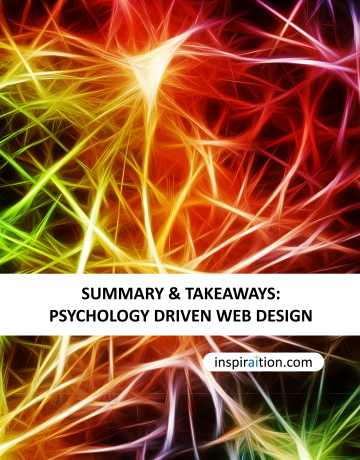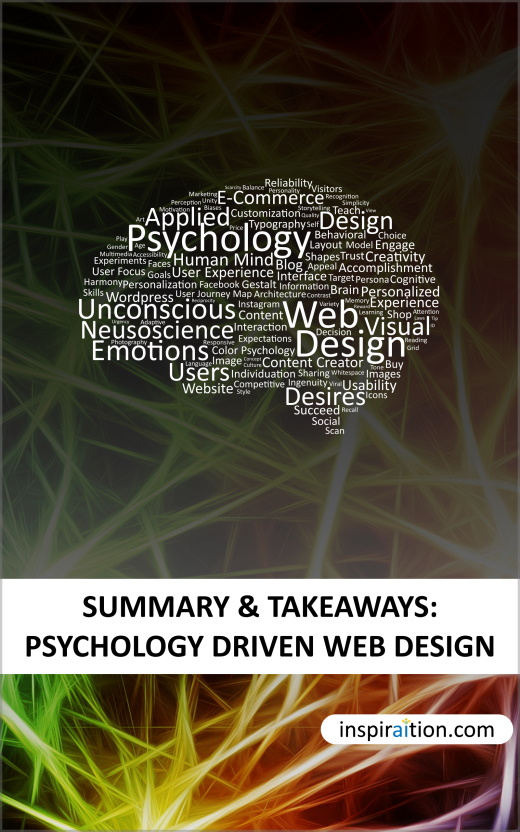Summary & Takeaways:
Psychology Driven Web Design
This book contains the major takeaways from our course Psychology Driven UX/UI/Web Design.
It explains on 150 pages how to design websites and apps using psychology and behavioral science as a foundation and will substantially improve your skills, whether you are a user experience, user interface, web, or app designer!
It is being sold as a kindle e-book as well as a printed book for a very low price at Amazon.com.
About the Course
In our course Psychology Driven UX/UI/Web Design, content creators can learn about the fundamentals of cognitive, behavioral, and social psychology, to the extent needed by a web designer, in laymen’s terms, and with lots of examples.
We published this summary separately from the course because not everyone may have the time required – roughly 40 hours of lectures – or the patience for that matter, to study the subject, which can take anywhere from four to eight months, depending on how rigorously one works on the assignments.
What you will find in the book, in contrast, is a much-compressed presentation of just the main points, which you can gloss over quickly. Entire concepts have been expressed with just one or two sentences here, as tips or guidelines. If you are someone who has a good design background already, these should be sufficient for you to integrate aspects that relate to human psychology into your future work. Otherwise, you can always take the online course to learn more about the issues that interest you.
The course booklet describes the details of each topic discussed in the lectures.
This Book will Benefit You!
People from all walks of life create websites nowadays. While in the founding years of the world wide web this activity was in the domain of professionals who knew how to code HTML, with the proliferation of content management systems such as WordPress, Drupal, Joomla, etc. and development platforms such as Wix.com, Weebly.com, Shopify.com, etc. today, anyone can come up with a good looking website in a short time.
But the problem is, these services offer templates or themes that are inevitably based on dummy content and therefore the creator must make sure the final design with content inserted is still effective. With over 250 million regularly updated websites on the internet, that look, in one way or another, similar, the only sure way to succeed is to cater to the psychology of users.
Many people find this difficult to accomplish though, since they lack the fundamentals in this important field of basic human knowledge. Not that professional web developers did or do study psychology, even though most in this group do have proficiency in at least graphic design.
However, usability, reliability, and even creativity, while required, are no longer sufficient to satisfy the expectations of website visitors.
Web designers, content creators, and even those who just publish to social networks must be able to appeal to the emotions and unconscious desires of their target audiences to be successful in today’s competitive world. This book can help with that!
This book is for:
- Web designers at all levels
- App designers at all levels
- User experience designers at all levels
- User interface designers at all levels
- Web content creators
- Bloggers
- Social media publishers
- Online shop owners
When you finish this book you will be able to:
- Design effective and affective websites and apps by focusing on user psychology.
- Use recent findings in neuroscience and applied psychology when creating online content.
- Consider the instinctive, emotional and rational manifestations of the human mind when publishing on the web.
- Use subtleties of human cognition for designing balanced and aesthetically pleasing websites.
- Use gestalt and visual design principles to build strong visual hierarchies that guide users to their goals.
- Use color with greater psychological impact in web and app design.
- Design for mobile environments and contexts.
- Create content that is suitable for scanning, better readable, more impactful and shared more.
- Select, stylize and optimize visuals and multimedia for inspirational use on web pages.
- Use typography and iconic representations with greater psychological impact in web design.
- Design e-commerce websites and customer experiences that convert much better.
- Improve usability of controls and design better user interactions by understanding limitations of human beings.
- Conceive personalized user experiences by learning to design for different psychological profiles of individuals.
- Use gamification to create more engaging websites.
We are working on a number of new and exciting projects.
Please follow us!

